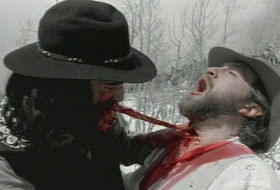As my fellow Americans and I prepare to gorge ourselves on hamburgers and s’mores (side note: does a s’more hamburger sound good, or am I just really hungry?), I thought it would be patriotic--or, well, timely--to round up a few installments of my favorite genre that represent some aspect of United States history. A complete timeline wasn’t possible because a) as far as I know, we’re still waiting for the proper Columbus-as-Godzilla analogy of my dreams and b) there aren’t nearly enough (that I know of) films set in the past.
Still, I did manage to pull a few titles/notable time periods for your movie marathon. No matter what color passport you may keep, feel free to add more below. Based on some of my picks, we need all the help we can to make history not repeat itself.
Puritannia!
Truth be told, I can’t think of any great American horror films that truly capture the restrictiveness of Christian culture. Peter Weir’s brilliantly haunting Picnic At Hanging Rock does an incredible job of exploring the unnatural atmosphere of Victorian society, but, well, that classic is set in the 1900s on another British colony that begins with A. For colonial horror of a more cerebral ilk, one could check out the we’re-the-real-monsters A-list headed The Crucible, starring a horny Winona Ryder, a brooding Daniel Day Lewis, and lots of black magic loving teenagers who scream more than all Jason’s final girls combined or an entire cycle’s worth of America’s Next Top Model contestants. If so-bad-it’s-still-not-good films are your cup of tea, then sit yourself down for an MST3K zinger-ready viewing of Demi Moore’s Oscar-baiting, Razzie winning performance as Hester Prynne in The Scarlet Letter. It teaches some important national lessons, such as don’t have sex with priests even if they are Gary Goldman and never under any circumstances overestimate your acting ability.
Manifest Destiny
Go west, young man! And if in doubt, eat your fatter travel companions. The infamous Donnor Party of the 1840s ventured into unchartered territory by heading across the country in search of gold and good settling ground, but they’re far more remembered for their survival spirit and taste in good old fashioned American red meat. American citizen meat, that is. Short on supplies and near starvation, these ill-fated pioneers eventually began eating their fellow (dead, I believe) travelers, thus beginning our national tradition of cannibalistic antiheroes. Without them, would Anthony Hopkins have ever won an Oscar? (probably). For totally unfaithful adaptations of this event, see the well-made Ravenous or Trey Parker and Matt Stone’s Tromarrific Cannibal! The Musical. Warning: you will be singing about baked potatoes, snowmen, and trackers for weeks without fail. And you may want to eat people. I honestly don’t know which is worse.
The Civil War
The bloodiest event in American history pitted brother against brother, North against South, and twangs against Yank speak. In terms of body count, it’s our most devastating war, although oddly enough, you won’t find a large amount of horror films addressing the subject. Near Dark adds an excellently evil layer to Lance Henrickson’s vampire by giving him a Confederate backstory (slavery supporting AND undead? shudders). One of my favorite forgotten horror anthologies, the Vincent Price starring From a Whisper to a Scream (aka The Offspring) sets its final segment during the last days of the Civil War, when a group of children orphaned by the North’s dominance find their own method of Reconstruction (hint: it involves a lot of pieces). The amateur acting is spotty, but the gritty barrenness of a war-torn society (rarely seen in the U.S. but sadly far more common elsewhere) is explored in a truly frightening way.
The 1960s
In 1968, George Romero changed American (and international) cinema with the gore-filled, hero lacking Night of the Living Dead. Aside from introducing the world to unlimited hours of entertainment in planning zombie escape plans, this little black and white horror captured a changing tide in national sentiment. The blatant acknowledgement of unequal treatment of blacks, the inefficiency of government authorities, and the disenchantment with the American heroism by the reality of Vietnam has aged well in the 40 years since it’s midnight premiere. It won’t make you proud of this country, but it remains one of its most important cinematic milestones.
Getting depressed by the state of the red white and blue? For an all-American palette cleanser, check out 1997’s low budget, high body count Uncle Sam. Yes, it’s pretty much 85 minutes of patriotic kills using every implement you’ll touch this July 4th (flag pole? check; bbq? check; firecrackers? you get the point) and no, it’s not good. But with American heroes Isaac Hayes and Robert Forster on board, plus the most aggressive potato sack race ever put on film, you’ll get much more enjoyment than, say, watching televised fireworks scored to the Last House On the Left-like raping of John Philip Sousa’s legacy by high school marching bands.




No comments:
Post a Comment